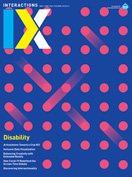Authors:
Daniela Rosner, Alex Taylor, Mikael Wiberg, Amanda Windle
"Nothing about us without us." When it comes to conversations on disability within HCI, few mottos more honor the urgency for access. Long embraced within disability activism, the phrase captures something endemic to the field: that what it means to be innovative is tied up with what it means to be visible.
Critical disabilities studies—a body of literature spanning law, economics, anthropology, history, and other fields—has paid particular attention to this visibility. Since at least 2011, when it was introduced to HCI by Jennifer Mankoff, Gillian R. Hayes, and Devva Kasnitz, this work has highlighted entrenched ableism within our range of design activities, from exporting a PDF file to developing assistive technology. Informed by concurrent activist movements, these critical perspectives call for confronting the ingrained assumptions of nondisabled designers, technologists, and researchers. They also prompt tech development to center the firsthand experiences of people with disabilities. Acknowledging a wider politics of exclusion, they challenge a design process premised on the important and sometimes overlapping dynamics of ableism with whiteness, maleness, cisgenderedness, and heterosexuality, among other axes of difference.
Contributions to this issue make an important, even hopeful, proposition: that technological worlds infused with inequity still hold the potential for change.
Contributions to this issue take us through these challenges to make an important, even hopeful, proposition: that technological worlds infused with inequity still hold the potential for change. To create the conditions for enacting change, they show us the range of learning and unlearning needed. This work includes recognizing the burden of asking people with disabilities to participate in studies (Kim Marriott); gathering a diversity of audiovisual learning materials for class syllabi (Laura Forlano); pushing against an ideology of monolingualism (Manuel Pérez-Quiñones and Consuelo Carr Salas); making the aging body integral to design for lived experience (Britta Schulte, Marie Louise Juul Søndergaard, Rens Brankaert, Kellie Morrisey); using intersectional frameworks to center those marginalized within design (Quincy Brown, Neha Kumar, Jakita Thomas, Alexandra To, Yolanda Rankin); and asking who is being designed for, by whom, and how (Elizabeth Churchill). In these reflections and inquiries, the contributions illuminate the need to prioritize access in all aspects of design.
Core to this discussion is the introduction of Crip HCI. Where some research strives to highlight ability rather than disability (arguing against a deficiency model), Rua Williams and interlocutors Kate Ringland, Amelia Gibson, Mahender Mandala, Arne Maibaum, and Tiago Guerreiro strive to amplify disabled perspectives. They speak to the importance of not only recognizing disability, but also grappling with the trouble within. With the term crip, they emphasize the plurality of approaches to making and sharing knowledge among disabled people. These knowledge practices work to refuse status quo design narratives. They teach us to forge new and different realities—what Williams calls a new, crip-affirming future.
Daniela K. Rosner, Alex Taylor, Mikael Wiberg, Amanda Windle [email protected]
Copyright held by authors
The Digital Library is published by the Association for Computing Machinery. Copyright © 2021 ACM, Inc.








Post Comment
No Comments Found